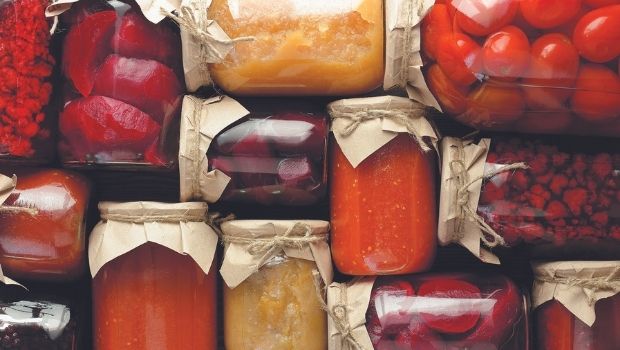Preserving the Harvest
Classic Ways to Store Garden Bounty All Year
Whether gardening, purchasing at farmers’ markets or ordering from a community supported agriculture farm, preservation techniques capture the bounty of the harvest and ensure availability of fresh flavors year-round.
Dehydrating
“Dehydrating machines can be purchased for about $50, but an oven that goes down to a temperature of 150 or less will work,” says Brekke Bounds, educator at City Grange, a garden center in Chicago. Before dehydrating, consider the end use. Peaches or cherries can be cut into bite-size pieces. Roma or cherry tomatoes, sliced or cut in half and dried, can go in winter soups and stews. “Apple chips are super-easy,” Bounds says. “Core and slice with a mandoline, dunk in a lemon solution, sprinkle with cinnamon, dehydrate and store in an airtight jar.”
Foods can be seasoned or marinated before drying. “We make zucchini bacon for vegan BLTs,” says Anthony Damiano, chef proprietor at Counter Culture restaurant, in Vero Beach, Florida. Dried herbs chopped in a food processor can be stored in airtight containers and used up to a year later as a flavorful salad toppings or soup mixes.
Canning
“One of my go-to methods is water bath canning,” says Emily Paster, author of The Joys of Jewish Preserving. “It’s a really safe and effective method of home preservation for high acid foods. Certain kinds of microorganisms, most specifically botulism, can’t live in a
high-acid environment.” Fruits that go into jams and jellies are typically acidic enough, but levels can be increased with lemon juice. Vegetable pickles become acidic through the addition of vinegar. Heat-sealed jars are shelf-stable if the seals remain intact. Paul Fehribach, chef and co-owner of Big Jones, a restaurant in Chicago, gives canning tips in The Big Jones Cookbook.
For pickles and preserves, he recommends using a simple canning kit with a tool to lift jars in and out of boiling water, a jar rack that sits in the bottom of a stock pot and Mason jars with new canning lids to hold the food. Both Paster and Fehribach suggest using professionally tested recipes. “Go to a reliable source, whether it’s a cookbook or a website, because there are some food safety issues. Recipes have been calibrated to have the right ratio of water and vinegar to vegetables to ensure it’s acidic enough,” says
Paster. “Pickles are a great place to begin because they’re really hard to mess up.”
Refrigerator Pickling
The pickling process can be done without water bath canning, but the jars must remain refrigerated. The fun is in the quickness and variability of the recipes. Beyond traditional cucumber pickles, excellent pickles can be made with green beans, carrots, onions, cauliflower and green tomatoes. Brine can be dill, spicy or sweet. Damiano makes refrigerator pickles with a variety of local organic produce, including radishes, okra and other vegetables. The pickles are great for eating and can be used in salads and recipes like
plant-based tostadas.
Fermenting
“Fermentation is an essential part of how people everywhere make effective use of food resources,” says Sandor Ellix Katz, fermentation revivalist in Liberty, Tennessee, and author of The Art of Fermentation. “Fermentation produces alcohol, helps preserve food by producing acids and makes foods more digestible, more nutritious, more delicious and sometimes less toxic.” Cultures around the world developed fermentation techniques as a practical method to prevent food decomposition. Studies show that fermented foods and beverages provide beneficial probiotics to the gut microbiome. Anyone can give fermentation a try with ordinary kitchen tools—a knife, cutting board, mixing bowl and a jar. “Certain ferments, such as yogurt or tempeh, require specific temperature ranges,” advises Katz.
Cold Storage
Many fruits and vegetables freeze well, but a basement or backyard root cellar is a no electricity, cold storage method. Items that store well in a root cellar include most root crops and firm fruits like apples and pears. “Root cellars use the natural, cool, moist conditions underground for fruit and vegetable storage. Earth-sheltered options work best for cooler climates where the ground temp is naturally cooler,” says Laurie Neverman in Denmark, Wisconsin, creator of CommonSenseHome.com. Those with no outdoor spot or cold basement room can still use cold storage.
“Some crops like onions, garlic, potatoes, winter squash, apples and carrots keep well in dark, dry, cool room temperatures of about 55 degrees,” says Neverman. Food preservation methods extend the blessings of the harvest. A little preparation now will provide edible delights for months to come.
Julie Peterson writes from rural Wisconsin. Reach out at JuliePeterson2222@gmail.com.

























